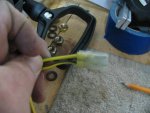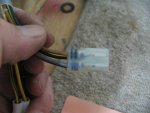Check Your Standards Please !!
Check Your Standards Please !!
Hey guy's,
Where are the alarm calls from the licenced maintenance guy's? Since when is soldering allowed on aircraft looming? I was taught, NEVER solder, only crimp. Especially doing both on a single joint !!!!!!!!
Even after soldering, solder is still in a fluid state, it will slowly deform, especially under vibration, the joint will weaken, the rest becomes "possible statistic".
Use a ratchet crimper guy's, a decent Daniels type, not a universal automotive clamp type, with the red, blue, yellow crimping positions, wire stripper and cutter combo type. Must be one that clamps all around, guides the inner tang ends around and inwards to firmly clamp the conductors, as well as the outer tangs a bit less, to clamp the insulation. Have a look at production crimps, it's not a simple squeeze flat operation, it has to compress in a sequence, and end in a small round diameter, to fit into the plug receptable. The ratched crimper ensures the correct clamping force is used.
The insulation stripping part is also critical, use a decent wire stripper, that does not damage the inner conductors, only cuts through the insulation. The stripped length is critical. The rear of the pin being crimped on must hold on to the insulation, and carry the bending load. Soldering does NOT give you that support, so the inners flex and eventually break off !!
You guy's are usually so "pedantic" on some issues, can't believe you are advocating solder joints for a high vibration environment.
If you can't afford an aircraft grade ratchet crimper, THEN DON'T TAKE A SHORTCUT, BORROW ONE !! Your life might depend on it!!
Hav'nt even touched on the corrosion issue of soldering..........
Soldered joints are NOT more reliable than crimped ones!! FACT !!
BTW, MOLEX connectors are designed to be crimped, not soldered.
Regards,
Francois





